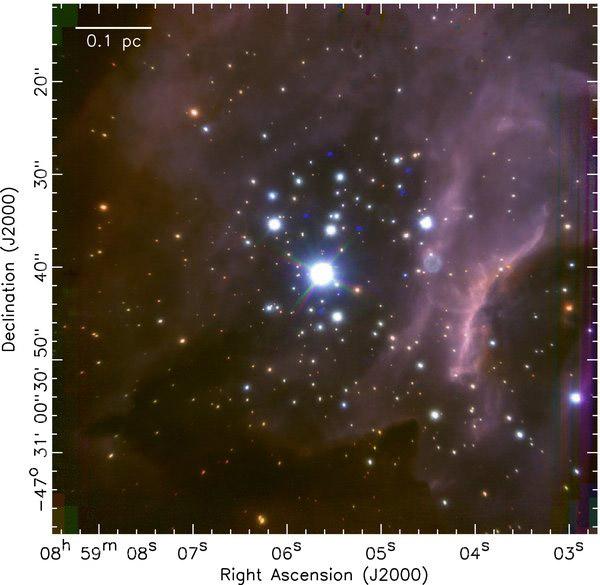
A infrared, false-color composite image of the massive young stellar cluster RCW 38. The axes label the position of the image in the sky, and the insert shows a length of 3.3 light-years at the distance of the cluster (for comparison, the closest star to our sun is about 4 light-years away). CfA astronomers studying this cluster have categorized 317 young stars and their environments.
One new star is born somewhere in our Milky Way galaxy per year, on average, according to the current estimates. The stellar nurseries are located in giant clouds of molecular gas and dust found throughout the galaxy, but are often hidden from optical view by the thick dust. Each of these fertile regions is expected to produce multiple stars, with the newborns arriving together in a dense cluster together with hundreds of siblings, but there are few studies of very young clusters or their properties. The implications are significant, though. The sun, for example, may also have formed in a cluster that later dissipated. Ultraviolet light can evaporate dust, and massive, hot stars that emit such light may have played a role by inhibiting the formation of planets if they were near the young sun; likewise, if a nearby massive star exploded as a supernova during the early days of the sun, the event might explain the abundances of radioactive elements found in the solar system.
The giant stellar nursery called RCW 38 is located about six thousand light-years away, and is one of only two relatively nearby giant clusters with over 1000 stars. The other one is the Orion Nebula, which is 3.5 times closer and much easier to study, and so thus far a unique example. Student Kim DeRose, a recent graduate, along with CfA astronomers Tyler Bourke, Rob Gutermuth, and Scott Wolk and three colleagues, used very high resolution imaging to study the RCW 38 cluster at near infrared wavelengths where the dust obscuration is less severe. They worked at a European 8.2-meter telescope in Chile that has "adaptive optics," a system that corrects for atmospheric distortion, and which can partially compensate for the larger distance to RCW 38 than to Orion.
The scientists detected 317 stars in the cluster at three infrared wavelengths. About thirty percent of them were noticeably red, suggesting the presence of circumstellar, perhaps protoplanetary, disks. They also found traces of shocked gas and a few even younger protostars, all features consistent with this being an active stellar nursery. The results are a significant advance because they represent the first time a massive cluster other than Orion has been studied so precisely. They offer the chance to determine which features of a cluster are characteristic of all clusters, and which (for example the spatial distribution of the stars, the numbers of different kinds of stars, or the numbers of stars with protostellar disks) are only circumstantial.